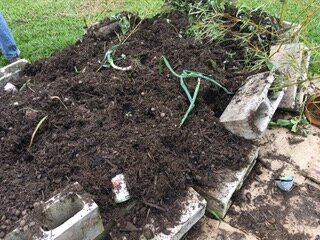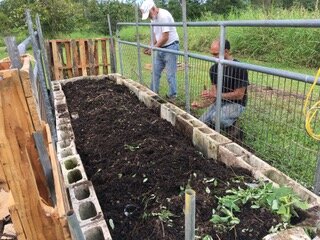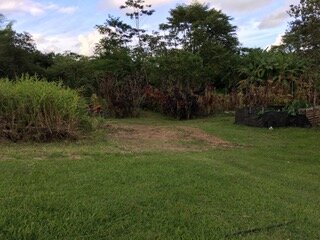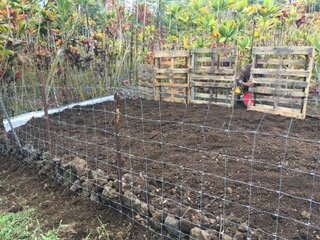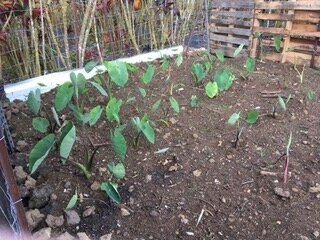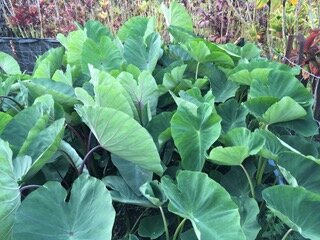Farming a Food Future
by Kirsten Kagimoto and Tanya Dreizin, Hawaiʻi Chapter Staff
There is no doubt that Aunty Deb is a living treasure. Small but mighty, Deborah Ward brings so much power to her work—whether it be farming, teaching, defending Mauna Kea or one of the many other environmental justice causes she stands for. We’ve gotten to know Aunty Deb over the years, and in the era of COVID-19, as we all reflect upon Hawaiʻi’s self-sustainability, the impact of our individual and collective actions and the new reality of shaping a different future for the islands, we thought it would be an opportune time to highlight all the hard work she does to feed her community and to defend Hawaiʻi’s precious natural resources. We hope this short interview will inspire others to get involved, grow their own food and support local agriculture even as the economy begins to reopen.
The Farm
How did you get into farming and when did you start your farm?
I developed a love of gardening when my children were small and I went to community college when they were in preschool. I loved botany and eventually decided on a Master’s degree at UH Mānoa in horticulture for self-sufficiency.
After searching for land on Hawaiʻi Island that I could afford, I was at home sick one day and a sign appeared on the property next door to the rental house I was living in. Fred Stone and I went down that day and made an offer! That was in 1996, I was 47, and just a few months later I was diagnosed with stage 3 head and neck cancer and went to UCLA for treatment. My plan for the property was to develop a native plant nursery, but I was given a short period to live, so we planted fruit trees instead, in hope that my children would eat the fruit.
We know you grow an amazing variety of crops on your farm. Can you summarize for us what you have?
We planted ‘ulu first, then lots of citrus, banana varieties, litchi and exotic fruits from all over the world. The farm has over 100 varieties now—some familiar, some unknown to most folks.
What is your favorite crop on your farm?
I love orange juice, so that is high on my list, but my new love is ‘ulu. I lived in Hawaiʻi for almost 50 years before it became a staple in my diet. I also grow and love kalo, ‘ōhiʻa ‘ai, ʻōlena and lots of edible herbs.
We've seen great photos of you at local farmers markets with a plethora of produce. Do you know how much food you provide to your community?
Probably 50-150 pounds a week. Some months, like March and April, have very little in terms of fruit, except bananas. When the fruit production is low, I dip into my freezer for all the fruit juices I make during abundance, and I make jams and preserves. I also sell frozen bananas to a local restaurant, herbs to a specialty shop, lilikoi juice to a local bakery and banana bread for B&Bs.
About Aunty Deb
What is your favorite part of farming?
EVERYTHING! There is never an unhappy day of weeding, pruning, harvesting, composting, saving seed and watching them grow. I love the social aspect of being an “ambassador of tropical fruit” at our market in Volcano, that caters to both local residents and nature-loving visitors.
What are the biggest challenges you've faced in your work as a farmer?
The biggest challenges...there are so many. Prices are too low to make a living, and on the flip side, when the demand is low at the end of the month when folks’ funds are short, having an abundance of fruit. Not to mention the invasive pests that have killed one after another of my crops: feral pigs recently destroyed my vegetable gardens, a gall wasp took out my wiliwili windbreak, banana bunchy top virus killed most of my banana varieties, little imported fire ants, and now we have the Queensland Longhorn Beetle that is attacking citrus, kalamungay, avocado, ʻulu and kukui.
How did you join the Sierra Club?
I have loved the outdoors since childhood and have always been an activist to speak for the trees (because humans can speak for themselves!). I joined the Sierra Club in 1983 to learn how to navigate the process of reviewing environmental impact statements and develop effective testimony. The Sierra Club offers a way to work with and learn from other folks who cherish the Earth’s natural wonders. I am grateful that Sierra Club members are among my finest friends! I have been active on the Hawaiʻi Island Group ExCom for over 35 years and am currently chairing the group, and seeking younger members to join our conservation committee, organize programs and lead hikes.
Can you tell our readers about the other work you do to protect Hawaiʻi Island and its people?
I became involved on Mauna Kea during one of my first trips to Hawaiʻi Island with my parents in 1971. My father was a physicist and an avid astronomer. I was stunned by the wild beauty when there was only one telescope that was only the size of a garage. The vista across the majestic cinder cones, the vast wilderness of lichens and the silence and surreal peacefulness left a vivid impression. My next trip was with Lorin Gill, where I learned about the devastation of the manane ʻāhinahina (silversword) ecosystem and the introduction of feral animals that imperiled the māmane and the palila. After graduating from UH Mānoa, I headed to Hilo to take a job as an agricultural Extension Agent in the early eighties and I joined Sierra Club within a year. I worked for 23 years with young people in the 4-H youth development program, started the Master Gardener program, and wrote the first water catchment bulletin when the volcano erupted and children were testing with high levels of lead from drinking water from catchment systems. I started school gardens on six campuses, and taught agricultural land judging to students and helped them understand the connection between land protection and community.
Hawaiʻi's Food Future
What do you envision for Hawaiʻi's food security future?
I would like to see everyone grow some of their own food to eat and to share. We may not be able to grow all the rice we eat, but certainly we can grow the kalo, ‘ulu, citrus, bananas, and many other fruits and vegetables we currently import. There are pockets of land in nearly every neighborhood that could be producing food. Schools should also have their own gardens and the support to maintain them.
For both small and large scale operations, there are many needs we should address now to increase our local food security in the long-term. Much of our agricultural land is being proposed for development, but should remain in agriculture or agroforestry. Hawaiʻi needs better agricultural inspection, dedicated funds for early invasive species detection, and vigorous efforts to contain early outbreaks to lessen the detrimental impacts of new incoming species like the Queensland Longhorn Beetle we are battling now. We also need better control of feral pigs, goats and deer. In terms of distribution, support for commercial kitchens and community refrigeration facilities would be a game changer for small farmers and cottage industries.
Lastly, across the board, we need to encourage the use of local foods, reduce the use of pesticides on crops by using integrated pest management, and assist our famers in the production of safe, pest free compost for wide-scale use.
What advice do you have for the next generation of farmers/gardeners?
Try new crops and new varieties, save seeds and share, and involve children in gardening!
Do you have any tips for people who want to get started growing their own food?
Get started! Don’t be discouraged! Grow something! Plants do well with observation and care! Find others who garden and share tips! The local Master Gardeners and Facebook groups can help you find answers.
How can people get involved with supporting local farmers?
Ask politicians who are running for office what they can do to support local ag, advocate for the many initiatives I listed above, and buy local whenever you can.
Aunty Debbie’s 8 Week Garden
“At the beginning of COVID-19, we decided to plant a garden—I am not a vegetable farmer, but I figured we had better be ready for anything—and it was almost immediately destroyed by pigs. So we fenced the tiled garden, replanted and eight weeks later we eat from it every night! We learned our lesson and fenced the next garden intended for kalo, eggplant and tomatoes and planted tiny little huli. Eight weeks later, the kalo leaves are almost 5 feet high, and we are making laulau with the leaves!”
When we started interviewing Aunty Deb about her visions of Hawaiʻi’s food future post-COVID, she referred us to the Feminist Economic Recovery Plan for COVID-19, which shares that in Hawaiʻi’s shift away from a tourism-based economy, Hawaiʻi should fund programs that stimulate:
“Sustainable economic futures by investing in subsistence living and the perpetuation of land- and sea-based practices traditional to Hawaiʻi's ecological and food system. This should include well preserved agricultural and aquacultural methods, agroforestry and land restoration efforts and technologies which foster mauka-to-makai and ridge-to-reef balance. Further, this investment should be fair and equitable to the resilience of ahupuaʻa resources, strengthen local food production and develop markets in sustainable materials (e.g. construction materials). These programs should also ensure nutrition and access to local food for all and are not dependent on economic status.”
Supporting local farmers and growing your own food and is one of the biggest ways you can have a positive impact on the climate crisis, strengthen local food production and decentralize our food systems. When you buy local, you help wonderful people like Aunty Deb continue in their mission to feed their communities and make local produce accessible to everyone.
We had the pleasure of visiting Aunty Deb’s farm and let us tell you—it is an unforgettable and inspiring place. The diversity and bounty that her farm supplies gives us hope that we can return to a time where most of us either grow our own food or support our neighbors that have green thumbs.
Outside of the farm, Aunty Deb herself is a ray of hope, resiliency and true inspiration. She has faced countless challenges in her life but she remains steadfast in her beliefs, treats everyone and everything with deep aloha and is one tough cookie.
Kirsten Kagimoto is the Strategic Communications Manager for the Hawaiʻi Chapter. She loves all things nature—especially her pets—and has a passion for empowering people of their place to manage their resources and take local action to increase resiliency in light of the climate crisis.
Tanya Dreizin is the Office Manager for the Hawaiʻi Chapter. She loves hiking, rock climbing, and traveling, sparking her inspiration to get involved with environmental causes to advocate for and protect the lands where we live and play.









